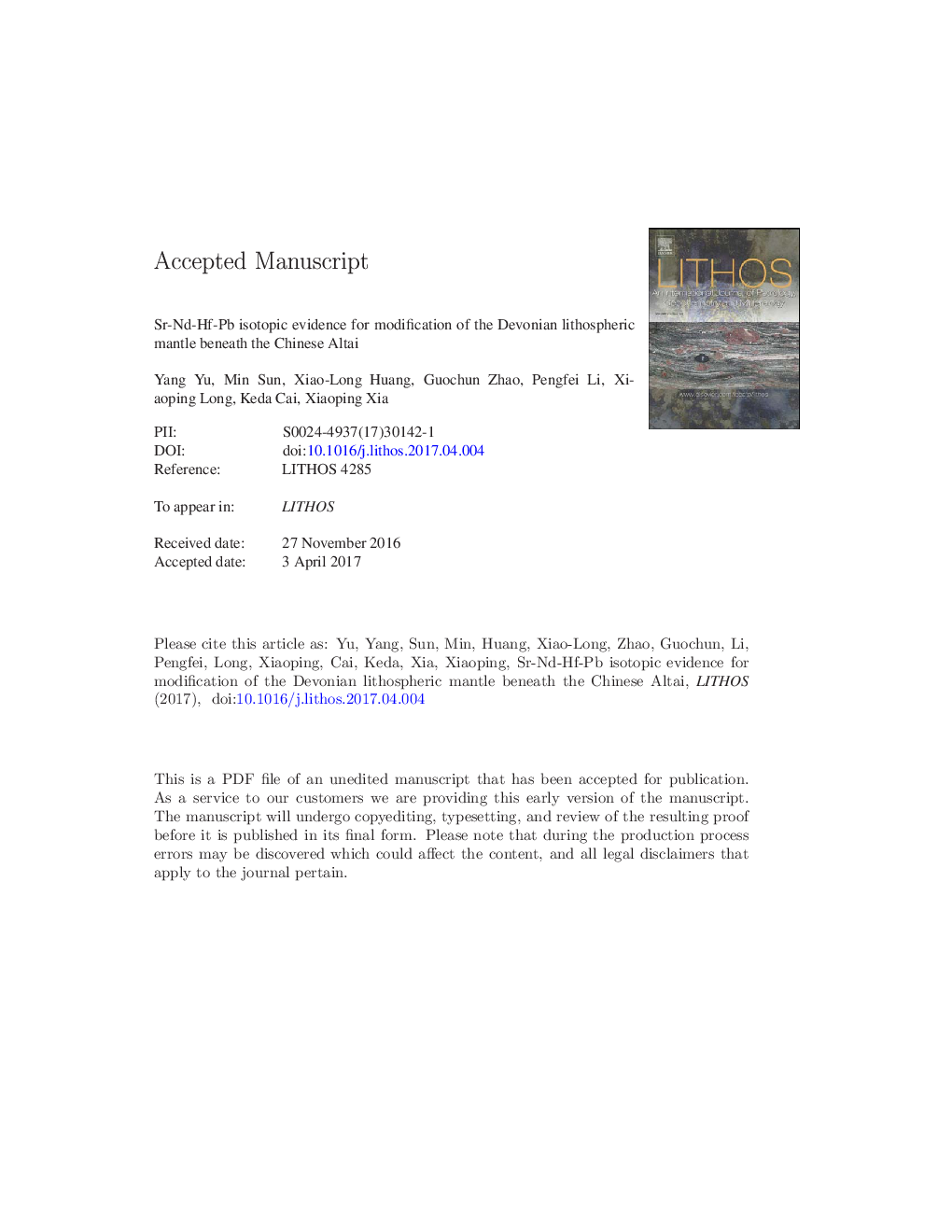| کد مقاله | کد نشریه | سال انتشار | مقاله انگلیسی | نسخه تمام متن |
|---|---|---|---|---|
| 5784038 | 1638630 | 2017 | 63 صفحه PDF | دانلود رایگان |
عنوان انگلیسی مقاله ISI
Sr-Nd-Hf-Pb isotopic evidence for modification of the Devonian lithospheric mantle beneath the Chinese Altai
دانلود مقاله + سفارش ترجمه
دانلود مقاله ISI انگلیسی
رایگان برای ایرانیان
کلمات کلیدی
موضوعات مرتبط
مهندسی و علوم پایه
علوم زمین و سیارات
ژئوشیمی و پترولوژی
پیش نمایش صفحه اول مقاله

چکیده انگلیسی
Intensive Devonian felsic magmatism is recorded within the southwestern Mongolian collage system of the Central Asian Orogenic Belt (CAOB). The voluminous magmas have isotopic compositions of juvenile materials from the mantle, thus manifesting significant mantle-crust interaction and continental growth at this time. Here, we present systematic Sr-Nd-Hf-Pb isotopic data for the Devonian mafic intrusions in the Chinese Altai, a key region within the southwestern Mongolian collage system to decipher the evolution of the mantle during this important tectonothermal event. The Keketuohai gabbro (409 ± 5 Ma) and type I mafic dykes (376 ± 5 Ma) within the Habahe complex have high (87Sr/86Sr)i, (206Pb/204Pb)t, (207Pb/204Pb)t and (208Pb/204Pb)t ratios, and decoupled Nd-Hf isotopic compositions; e.g., low εNd(t) values (â 2.5 to + 5.4) combined with high εHf(t) (+ 2.6 to + 15.1) values. These rocks have low Ba/La and high La/Yb and Th/Yb ratios, and are enriched in Pb, the light rare earth elements (LREE) and Th. They formed from magmas generated from the depleted lithospheric mantle metasomatised by hydrous melts from subducted sediments. In comparison, the gabbroic samples from the Habahe complex (369 ± 3 Ma) are enriched in the LREE, Th and Ba and have high La/Yb, Th/Yb and Ba/La ratios. They do not show significant Pb anomalies, and have depleted isotopic compositions that include low initial 87Sr/86Sr, 206Pb/204Pb, 207Pb/204Pb and 208Pb/204Pb ratios and high εNd(t) (+ 7.4 to + 7.8) and εHf(t) (+ 13.4 to + 15.3) values. These rocks are thought to have formed from magmas derived from the lithospheric mantle metasomatised by hydrous melts from subducted oceanic crust. The type II mafic dykes within the Habahe complex are depleted in the LREE and Th, have high Ba/La ratios, and are enriched in Pb, Ba, Sr, and U. They have positive εNd(t) (+ 7.6 to + 8.1) and εHf(t) (+ 14.1 to + 15.4) values, high initial 87Sr/86Sr, 206Pb/204Pb, 207Pb/204Pb and 208Pb/204Pb ratios, and are thought to have formed from a magmas generated by the partial melting of the depleted lithospheric mantle metasomatised by fluids derived from subducted sediments. The melting and dehydration of subducted oceanic crust and sediments indicate the Devonian subduction of a hot slab beneath the Chinese Altai, which could be related to a ridge subduction model previously proposed. The involvement of hydrous melts and fluids promoted the melting of the lithospheric mantle which was responsible for intensive felsic magmatism with abrupt increase of juvenile component and high temperature metamorphism in the region.
ناشر
Database: Elsevier - ScienceDirect (ساینس دایرکت)
Journal: Lithos - Volumes 284â285, July 2017, Pages 207-221
Journal: Lithos - Volumes 284â285, July 2017, Pages 207-221
نویسندگان
Yang Yu, Min Sun, Xiao-Long Huang, Guochun Zhao, Pengfei Li, Xiaoping Long, Keda Cai, Xiaoping Xia,